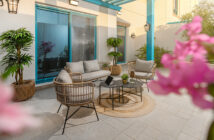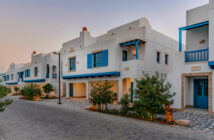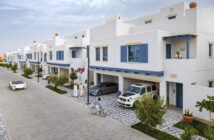Photos by Abdulaziz Muhaysin and Ahmad Ramadan
For over 30 years, the Tuwaiq Palace, one of architecture’s greatest marvels, stands strong and still in the Diplomatic Quarter. This cultural and social facility represents Saudi Arabia’s past, present, and future: echoing its history and heritage, adapting to the ever changing Riyadh cityscape, and looking forward to the modernity and advancements of the 21st century.
In the northwest side of the Diplomatic Quarter (DQ) lies its heart: the impressive cultural building called the Tuwaiq Palace that beats in accordance with the city its built upon. Like Riyadh, Tuwaiq Palace is known for its series of contrasts: it’s a garden in the middle of a desert, a structure inspired by traditional nomadic shelters but houses the latest computerized technology, and a solid, secured building that stands in an open courtyard. The Tuwaiq Palace is an iconic landmark in Riyadh and it’s here to stay.

Started in 1983 by the OHO Joint Venture of Frei Otto, Buro Happold, and Saudi architect Basem Shihabi of Omrania, the Tuwaiq Palace was first named Diplomatic Club. It was finished in 1985 and was renamed in 1987 to Tuwaiq Palace after a mountain located outside Riyadh. Like its namesake, the Tuwaiq Palace exits in a plateau. It occupies 75,000 sqm of land and overlooks the lush Wadi Hanifa and the glittering Riyadh skyline. Its design was made in harmony with the environment where it was built and it followed the land contours and embraced the greens of the area.
This design won the Aga Khan Award for Architecture in 1998. “The Tuwaiq Palace pays homage to the Arabic culture and heritage and at the same time, uses highly modern innovation and technologies.” In Arthur Clark’s article on Riyadh’s New DQ published in Aramco World 1988, Saudi architect Basem Shihabi was quoted on saying that there was no single inspiration for the palace. He said that “there was a great deal of tossing thoughts of how to combine the strong physical features of the site with its strong limitations. We needed to have a green, lush space to make it happy for visitors.” And indeed, they succeeded in doing just that.
The architecture of the building is influenced by the Najd design known for its mud walls, introverted design and narrow, winding streets. It reflects two major symbols of the Kingdom’s architectural heritage: the fortress and the tent. The tent-like structures made of Teflon-coated fiberglass are inspired by the nomadic shelters put up in the edges of the city; some in the middle of the desert exposed to the harsh weather conditions but still standing strong and defying the odds. It has been over 30 years since the Tuwaiq was built but it still looks amazing; enduring the test of time with its daring design, well-thought-of layout and complex engineering. The Tuwaiq Palace gathers together the elements of terraces, courtyards, and caves into its space and turns itself into an oasis, the central cultural facility in the DQ. In a latter article titled A Counterpoint of Cloth and Stone for the same magazine, writer Clark quoted Abdulrahman M. Al-Sari, former Director of Urban and Cultural Development of the ADA (then known as Riyadh Development Authority) saying “Tuwaiq Palace is definitely unique. It’s one of the examples that we use to show how to build a building that belongs to the place and space it’s erected in. It belongs to Riyadh, to the wadi, to that particular location.” “The Tuwaiq Palace belongs to Riyadh, to the wadi, to that particular location.”

The centerpiece of the palace’s garden is the Heart Tent, a stunning canopy of over 2,000 hand-painted stained glass. Designed by Bettina Otto, daughter of architect Frei Otto, the Heart Tent sits like a fine jewel in the midst of the property. When the sun shines during the day, the glass shimmers like fish scales and its myriad colors become more vibrant than ever. It bathes its surroundings with dancing colors of reds, oranges, blues, greens and hues in between. It’s one of the most known facets of the Tuwaiq Palace and it’s a beauty one must definitely see.

The Tuwaiq Palace is the venue of government functions, state receptions, and cultural festivals. It houses conference facilities including lounges, multi-purpose reception halls, and dining rooms. It has courts meant for sports like squash and tennis, alleys for bowling and pools for swimming. It also has a library for research and reading and 30 rooms that accommodate guests. Most embassies located in the DQ hold their National Day celebrations and ma’salamah parties for outgoing staff in the palace. Only government institutions and embassies can use the palace for their events and activities but if you’re in the area, you might get a glimpse of one of Saudi Arabia’s major landmarks.
FAST FACTS
Management: Arriyadh Development Authority
Architect: OHO Joint Venture: Atelier Frei Otto / Buro Happold / Omrania Associates
Project Value: GBP 22.5 million (SAR 106 million)
Total Site Area: 75,000 m2
Total Ground Floor Area: 8,503 m2
Completion: 1985
MOMENTS at the TUWAIQ PALACE
Guests divulge what makes the palace memorable for them.

“Considering that Tuwaiq Palace ages back to almost three decades, it’s still a marvellous structure with its architecture and great unhindered views. I love being on the terrace because it truly makes me feel that my beloved Riyadh is an oasis in the desert.” Cyma Aziz, TV Anchor of KSA 2
“The Heart Tent is a marvel both in day and night. It is unlike any structure I’ve ever seen in the entire city. Simply picturesque!” Salma Haddad, DQ resident
“Tuwaiq Palace is a unique building in Riyadh, which offers an original panorama with series of contrasts; desert and garden , modern and traditional architecture at the same time. The concept of the interior design seems to introduce the Saudi arts to the international community and embassies that are frequently choosing to organize there their receptions. We have enjoyed our Albanian National Day reception in Tuwaiq Palace last year and most probably we might be there this year as well.” Jonida Drogu, Diplomat, Albania Embassy
“I’ve attended many functions and special events at Tuwaiq Palace. We organized the annual SIDF banquets where the organization would celebrate employee anniversaries. I can recall the special evening where the head of SIDF recognized me for my longstanding contributions.” Fayez Al Saad a DQ resident and former employee of the Saudi Industrial Development Fund (SIDF)
“Lovely setting. Beautiful design.” Sally Kennedy, Owner of The Good Ship Lollipop
Tuwaiq Palace
2664, Alhattan Street,
Diplomatic Quarter,
Al Safarat, Riyadh 12513,
Saudi Arabia Contact
No.: +966-11-802-1919




